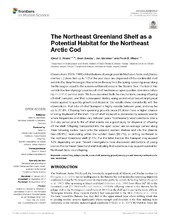| dc.contributor.author | Strand, Kjersti Opstad | |
| dc.contributor.author | Sundby, Svein | |
| dc.contributor.author | Albretsen, Jon | |
| dc.contributor.author | Vikebø, Frode Bendiksen | |
| dc.date.accessioned | 2018-01-05T09:38:14Z | |
| dc.date.available | 2018-01-05T09:38:14Z | |
| dc.date.issued | 2017-09-26 | |
| dc.Published | Strand KO, Sundby S, Albretsen J, Vikebø FB. The Northeast Greenland shelf as a potential habitat for the Northeast Arctic cod. Frontiers in Marine Science. 2017;4:304 | eng |
| dc.identifier.issn | 2296-7745 | en_US |
| dc.identifier.uri | https://hdl.handle.net/1956/17138 | |
| dc.description.abstract | Observations (1978–1991) of distributions of pelagic juvenile Northeast Arctic cod (Gadus morhua L.) show that up to 1/3 of the year class are dispersed off the continental shelf and into the deep Norwegian Sea while on the way from the spring-spawning areas along the Norwegian coast to the autumn-settlement areas in the Barents Sea. The fate of this variable fraction of pelagic juveniles off-shelf has been an open question ever since Johan Hjort's (1914) seminal work. We have examined both the mechanisms causing offspring off-shelf transport, and their subsequent destiny using an individual-based biophysical model applied to quantify growth and dispersal. Our results show, consistently with the observations, that total off-shelf transport is highly variable between years and may be up to 27.4%. Offspring from spawning grounds around Lofoten have a higher chance of being displaced off the shelf. The off-shelf transport is dominated by episodic events where frequencies and dates vary between years. Northeasterly wind conditions over a 3–7-day period prior to the off-shelf events are a good proxy for dispersal of offspring off the shelf. Offspring transported into the open ocean are on average carried along three following routes: back onto the adjacent eastern shelves and into the Barents Sea (36.9%), recirculating within the Lofoten Basin (60.7%), or drifting northwest to the northeast Greenland shelf (2.4%). For the latter fraction the transport may exceed 12% depending on year. Recent investigations have discovered distributions of young cod on the northeast Greenland shelf indicating that conditions may support survival for Northeast Arctic cod offspring. | en_US |
| dc.language.iso | eng | eng |
| dc.publisher | Frontiers | en_US |
| dc.rights | Attribution CC BY | eng |
| dc.rights.uri | http://creativecommons.org/licenses/by/4.0 | eng |
| dc.subject | Connectivity | eng |
| dc.subject | pelagic juvenile | eng |
| dc.subject | cross-shelf | eng |
| dc.subject | spawning ground | eng |
| dc.subject | nursery ground | eng |
| dc.subject | forecast | eng |
| dc.subject | northeast arctic cod | eng |
| dc.subject | Recruitment | eng |
| dc.title | The Northeast Greenland shelf as a potential habitat for the Northeast Arctic cod | en_US |
| dc.type | Peer reviewed | |
| dc.type | Journal article | |
| dc.date.updated | 2017-12-01T12:08:24Z | |
| dc.description.version | publishedVersion | en_US |
| dc.rights.holder | Copyright 2017 The Author(s) | en_US |
| dc.identifier.doi | https://doi.org/10.3389/fmars.2017.00304 | |
| dc.identifier.cristin | 1495206 | |
| dc.source.journal | Frontiers in Marine Science | |
| dc.relation.project | Norges forskningsråd: 244262 | |

